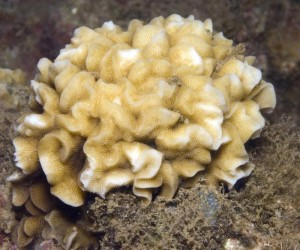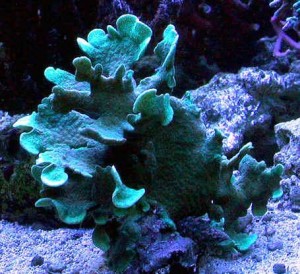Though cactus corals or Pavona corals are not the most attractive ones regarding color and texture, their pattern of growth is what makes them unique and a substantial addition to reef tanks. Also known as lettuce coral they can be found in purple, brown, and different shades of green and have polyps on both sides of the leaf. The shape resembles potato chips and found to be the most interesting pattern among SPS corals. They have marks all over them which can be sometimes not clearly visible due to the hairy extensions over them.
Cactus corals have lean, delicate skeletons and remarkable growth prototype that often look like clusters of petals. As opposed to normal wild behavior of most corals in tanks, many of its species extend their polyps during the day. They don’t grow that fast and their resistance to disease upon breaking makes them good corals for captive propagation by fragmentation. The best thing about these corals is that they don’t hodgepodge altogether when they grow. The neatness remains intact. This is my reason why I admire these corals. Another reason is that they have a fluorescent glow that can be seen beneath the polyps that are too good to be ignored.
It has been usually found that SPS corals are likely to be more intricate to care for as compared to LPS corals. However, Pavona corals hardy needs efforts once it has been well placed in your tank. With good intensity of light and strong random current, they will flourish with ease. Lighting could be moderate to high depending on the size of corals. Sometimes cactus corals might change its color due to change in light type or intensity; that does not necessarily mean that it is unhealthy. It might be just adjusting itself to new lighting conditions. Even when they might be looking dulled, it could just an acclimation to light change. Moderate to strong water flow is essential to keep debris from settling on the Cactus Coral for feeding and to prevent sediment damage of cactus corals.
Pavona are photosynthetic and produce their food from lighting of the tank. Calcium, strontium, and other trace elements can to be added to the water for its sustained good health. Its tentacles are visible in the evening and at that time you can feed it with additional food in the form of micro-plankton or brine shrimp. Since the polyps are small, they feed on small particles mostly and target feeding may not be required. Favorable water condition is 72-78° F, dKH 8-12, pH 8.1-8.4, and sg 1.023-1.025.
Propagation is same as most SPS corals. You can use clippers and break off pieces from the main colony. It is better to break off branches from where they fork off. Then you can glue it to another piece of live rock or a frag plug. After the glue dries up you can place it back into the tank. Pavona are peaceful corals and you must place them safely away from aggressive corals. Word cactus might make one think of a perilous coral but these are anything but harmful. In very rare cases have reported to have infections from cactus corals and that too was mild enough to be handled.





